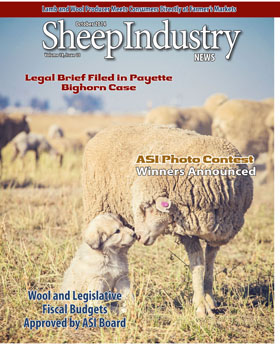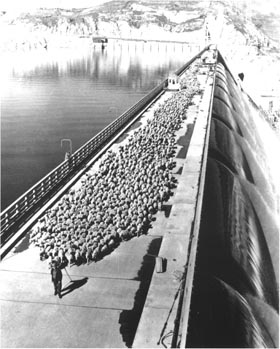
- October 2014
- President’s Notes
- ASI Team Represents Industry in Nanjing
- Belt Buckle Commemorates ASI’s 150th Anniversary
- Colorado Youngster Constructs Lego Camp in Honor of Family Heritage
- Commentary: Recent Headlines Are Example of Public’s Misunderstanding of Protection Dogs
- Dan Wilson: The Best Lamb Marketer is Usually the Person Who Raised the Lamb
- Grazing Allotments, Bighorns Take the Stage at Public Lands Council Meeting
- Market Report
- Nomination Deadline for Annual ASI Awards: Nov. 15
- Opening Brief Focused on Forest Service Payette Errors
- Sheep Budgets for 2014 Approved by Board
- Sheep News in Brief
- Working Together to Make Sheep Better
To View the October 2014 Digital Issue — Click Here

Time Changed Use of Land, Sheep Migration
By Clink Krebs
I recently had the opportunity to attend the Choteau Sheep Exposition in Choteau, Montana. This was the 13th year for this event where rams and ewes are sold by private treaty.
They do not use a live auctioneer or a silent bid process, but a unique method of combining the two. It has been highly successful for them, and it occurred to me other areas of the country might be able to take advantage of “what works for them” to sell smaller lots of good breeding sheep, with many different breeds being offered for sale.
I am sure if you contact Brent Roeder of the Montana Wool Growers ([email protected]), who is also President of the Sheep Expo, he would be glad to help other groups understand their process.
It was great to run into three of my old neighbors from 35 years ago who are still raising sheep, and share some of the old stories. I was asked me to give a presentation on the moving of sheep from the Columbia Basin onto the eastern slope of the Rockies, which is a migration my family and many others made for almost 50 years.
I thought it was interesting the most asked question was, “why did you quit”? I had to think about my answer.
I think the biggest reason was the change in the demand for the land. Before the building of Grand Coulee Dam, and dozens of other dams on the Columbia River, there were hundreds of thousands of sheep winter grazing of sagebrush steppe. Today, there are over a million acres under irrigation raising everything from grapes to carrots and potatoes.
My two neighboring ranches which probably ran 10,000 ewes in the 1960s and 70s on sand, sagebrush and solitude, are now home to a coal fired electrical generating plant, three 20,000 head dairies, a 30,000 head cattle feedlot, plus 36,000 acres of irrigated farm ground.
The east slope of northern Montana was all rolling grassland, and now thousands of acres have been plowed and put into grain production. As I drove through the small town of Fairfield, Montana – where there used to be a small railroad stockyard with one loading chute – there is now enough grain storage to hold over 2 million bushel of wheat or barley.
It wasn’t that sheep were not making profits, it was the fact more profit could be made from other uses of the land.
Moral of This Story: Keep the Help Busy
So, once upon a time, there were two young ranch kids, quietly minding their own business and not getting into any trouble, when they noticed a skunk crawling into a culvert.
They had been told that a skunk cannot squirt you unless he can raise his tail, and this culvert was small enough to prevent the tail from coming up, so these two young lads saw this as a great opportunity to test this theory. One got on one side and one on the other and with a couple of sticks they moved the skunk from one end to the other, and yes the theory must be correct because neither got squirted.
Then they decided to catch the skunk in a box, which they searched high and low for and couldn’t find, so they improvised with an old suitcase. The skunk was prodded out of the culvert and into the suitcase and the lid was tightly secured.
Everything went fine, but it now occurred to them, that opening the lid would allow the tail to be lifted. They left the suitcase by the side of the road as they moved away to find longer sticks and about that time a car came to a stop and stole their suitcase. The two boys were very disappointed as the car sped away, but shortly thereafter the car came to a screeching stop, all four doors flew open and the four people jumped out.
About a minute later the skunk hopped out of the car and went back to where he came from, and the car left again. So the moral of the story is, always have plenty of work for young boys.

